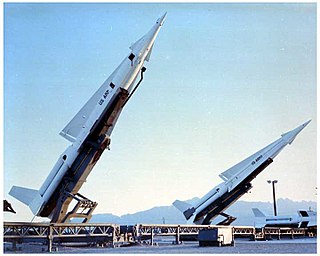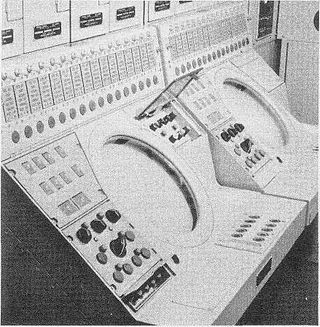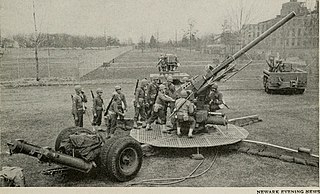Related Research Articles

The M51 Skysweeper was an anti-aircraft gun deployed in the early 1950s by both the U.S. Army and U.S. Air Force. It was the first such gun to combine a gun laying radar, analog computer (director) and an autoloader on a single carriage.

The Nike Hercules, initially designated SAM-A-25 and later MIM-14, was a surface-to-air missile (SAM) used by U.S. and NATO armed forces for medium- and high-altitude long-range air defense. It was normally armed with the W31 nuclear warhead, but could also be fitted with a conventional warhead for export use. Its warhead also allowed it to be used in a secondary surface-to-surface role, and the system also demonstrated its ability to hit other short-range missiles in flight.

The 90 mm gun M1/M2/M3 was an American heavy anti-aircraft and anti-tank gun, playing a role similar to the German 8.8cm Flak 18. It had a 3.5 in (90 mm) diameter bore, and a 50 caliber barrel, giving it a length of 15 ft (4.6 m). It was capable of firing a 3.5 in × 23.6 in shell 62,474 ft (19,042 m) horizontally, or a maximum altitude of 43,500 ft (13,300 m).

A fire-control system (FCS) is a number of components working together, usually a gun data computer, a director and radar, which is designed to assist a ranged weapon system to target, track, and hit a target. It performs the same task as a human gunner firing a weapon, but attempts to do so faster and more accurately.

The SCR-268 was the United States Army's first radar system. Introduced in 1940, it was developed to provide accurate aiming information for antiaircraft artillery and was also used for gun laying systems and directing searchlights against aircraft. The radar was widely utilized by both Army and Marine Corps air defense and early warning units during World War II. By the end of World War II the system was already considered out of date, having been replaced by the much smaller and more accurate SCR-584 microwave-based system.

The SCR-584 was an automatic-tracking microwave radar developed by the MIT Radiation Laboratory during World War II. It was one of the most advanced ground-based radars of its era, and became one of the primary gun laying radars used worldwide well into the 1950s. A trailer-mounted mobile version was the SCR-784.
Ground-directed bombing (GDB) is a military tactic for airstrikes by ground-attack aircraft, strategic bombers, and other equipped air vehicles under command guidance from aviation ground support equipment and/or ground personnel. Often used in poor weather and at night, the tactic was superseded by an airborne computer predicting unguided bomb impact from data provided by precision avionics Equipment for radar GDB generally included a combination ground radar/computer/communication system and aircraft avionics for processing radioed commands.

A director, also called an auxiliary predictor, is a mechanical or electronic computer that continuously calculates trigonometric firing solutions for use against a moving target, and transmits targeting data to direct the weapon firing crew.

The Raytheon AN/MSQ-18 Battalion Missile Operations System was a Project Nike command, control, and coordination system for "each associated missile battery" to control a Nike missile as directed from a Raytheon AN/MSQ-28 at the Army Air Defense Command Post. Raytheon Company constructed the AN/MSQ-18 as 2 separate subsystems:
Combat Skyspot was the ground-directed bombing (GDB) operation of the Vietnam War by the United States Air Force using Bomb Directing Centrals and by the United States Marine Corps using Course Directing Centrals. Combat Skyspot's command guidance of B-52s and tactical fighters and bombers—"chiefly flown by F-100's"—at night and poor weather was used for aerial bombing of strategic, close air support, interdiction, and other targets. Using a combination radar/computer/communications system at operating location in Southeast Asia, a typical bombing mission had an air command post turn over control of the mission to the radar station, and the station provided bomb run corrections and designated when to release bombs.
The AN/MPQ-2 Close Cooperation Control Unit was a truck-mounted post-World War II automatic tracking radar/computer/communication system for aircraft command guidance, e.g., missile tracking, and for Radar Bomb Scoring. For ground directed bombing (GDB), an operator would manually plot a target on the "Blind Bombing Plotting Sheet", then use the manual "E6B computer and bombing tables" to plot the release point for striking the target, after which a radar operator used the MPQ to acquire a track of the bomber near an initial point during which allowed ground control of the bomb run to the release point.
The AN/TPQ-2 Close Air Support System was a post-World War II radar/computer/communications system for automatically tracking an aircraft and guiding it to a predetermined bomb release point. The system was the predecessor of the General Electric AN/MPQ-14 Course Directing Central deployed to the Korean War for ground-directed bombing.
Matador Automatic Radar Control (MARC) was a command guidance system for the Martin MGM-1 Matador ground launched cruise missile that used combination radar/computer/communication centrals for ground-directed bombing. As for the earlier ground central used with the X-10 aircraft,* MARC had an "Air Link" from the ground for control and an airborne AN/APW-11A radar transponder on the missile for ranging. A series of "MSQ sites". each with a mobile AN/MSQ-1A central in 3 vans had an automatic tracking radar to geolocate the Matador up to ~600 nmi. MARC provided command guidance during the "mid-course phase" after Matador/MARC contact was established following the missile launch off the Zero Length Launcher and until an MSQ transmitted the dive ("dump") command to start the flight path toward the target. Originating in the Caltech/Martin "ZEL Project" and developed as part of weapon system "Project MX 771" at the "Air Force Missile Test Center, Cocoa, Florida"; MARC had accuracy at "crossover into enemy territory" of ~500 ft (150 m) and—at an AN/MSQ-1A range of 165 nautical miles —a CEP of 2,700 ft (820 m).
The Reeves AN/MSQ-51 Aerial Target Control Central (ATCC) was a combination radar/computer/communications system developed 1961-3 for United States Navy "aerial target out-of-sight control". In addition to the "Target Control System AN/SRW-4D" with radios and "Antenna Assemblies for Target Control and Communications ", the ATCC included acquisition/surveillance and tracking radars, a Mark X IFF/SIF, and an analog computer. The ATCC's automatic tracking radar was derived from the Western Electric M-33 gun laying radar and could process double-pulse 9340-9370 MHz beacon returns from transponders up to 400,000 yd away from the AN/MSQ-51 transmitting 9215-9285 MHz radar pulses. If an ATCC was equipped with a "Telemetry Receiving Station", IRIG channels 5-14 could also be received from QF-9G and Q-2C unmanned aerial vehicles. Other ATCC-controlled drones included the QF-9F, KDA-1, KDA-4, KDB-1 and KD2R-5. For "RF communications " to command the drone was a "Collins Radio Co. Model 618T-3" Single Sideband Transceiver (SST) with Control Unit 714E-2 for 28,000 channels. The 1000 watt voice radio system had 2 UHF AN/GRC-27 sets "with Control-Indicator 6-806/GR" for 1750 channels
The Reeves AN/MSQ-1 Close Support Control Set produced by Reeves Instrument Corporation was a trailer-mounted combination radar/computer/communication developed under a Rome Air Development Center program office for Cold War command guidance of manned aircraft Developed for Korean War ground-directed bombing, one detachment of the 3903rd Radar Bomb Scoring Squadron bombed itself with an MSQ-1 because it mistakenly used procedures for the earlier SCR-584/OA-294 system The MSQ-1 was subsequently used for nuclear testing during Operation Teapot, and for aircraft tests such as for "MSQ-1 controlled pinpoint photography" in 1954.

Radar, Anti-Aircraft Number 3 Mark 7, also widely referred to by its development rainbow code Blue Cedar, was a mobile anti-aircraft gun laying radar designed by British Thomson-Houston (BTH) in the mid-1940s. It was used extensively by the British Army and was exported to countries such as Holland, Switzerland, Sweden Finland and South Africa. In British service, it was used with the 5.25 inch and QF 3.7 inch AA guns, as well as the Brakemine missile.

The General Electric AN/TPQ-1O Course Directing Central was a light-weight, two-unit, helicopter transportable, ground based bombing system developed for use by the United States Marine Corps to provide highly accurate, day/night all weather close air support. This self-contained system was designed to guide an aircraft, equipped with the proper control equipment, to a release point for accurate all-weather delivery of ordnance and supplies to a preselected target. The AN/TPQ-10 and its operators were known as an ‘’Air Support Radar Team’’ (ASRT) and were employed by the Marine Air Support Squadrons within the Aviation Combat Element.

The M9 Gun Director was an electronic director developed by Bell Labs during World War II. This computer continuously calculated trigonometric firing solutions for anti-aircraft weapons against enemy aircraft. When cued by the SCR-584 centimetric gun-laying radar and used in concert with anti-aircraft guns firing shells with proximity fuzes, it helped form the most effective anti-aircraft weapon system utilized by the Allies during the war.
References
- 1 2 Tufft, 2nd Lieutenant A. H. (July–August 1953). "30th AAA Group Evaluation Tests". Antiaircraft Journal: 31.
The range factor for the SCR 584 modified for 90,000 yards range is 70. The range factor for the M33 with maximum range of 125,000 yards is 120. In the event of an SCR 584 that has not been modified for 90,000 yards, a ratio may be set up to determine the actual range factor to be used.
NOTE: "Range Factor" normalized scores for units using different gun laying systems (e.g., M33 by "A" Battery, 1st Battalion) and reduced unit scores for the more accurate M33 compared with batteries using "SCR-584 type radars" (e.g., "B" battery 3rd Battalion). In particular, M33 units received 100% for tracking if radar lock began at 120,000 yards, while units with modified SCR-584 systems received 100% tracking scores for initial lock at 90,000 yards. (Total score was the average of those for tracking, battery strength, and probability of kill based on the computed fuze setting transmitted to the guns when firing was commenced: e.g., a 100% average was "Target Destroyed".) - ↑ "The M-33 tracking radar uses a metallic lens antenna".
- 1 2 3 4 5 "Section II. DESCRIPTION…". Antiaircraft Fire Control System M33C and M33D Operation (Technical Manual 9-6092-1-1). United States Army. June 1956. (partial transcription at: "Fire Control Systems". Army Air Defense in the European Theater. USArmyGermany.com. Retrieved 2013-03-24.)
- ↑ Western Electric (25 April 1955). "Jet Bombers Won't Wait…" (full page advertisement). Life magazine . (fresnel antenna on top of trailer along helmeted soldier on ground looking skyward, 3 guns firing in background, moving jeep at right)
- ↑ History of Strategic and Ballistic Missile Defense, 1945-1955: Volume I (PDF). Archived from the original (PDF) on 10 November 2013. Retrieved 31 March 2013.
[LASHUP] Stations were undermanned, personnel lacked training, and repair and maintenance were difficult. This stop-gap system later would be replaced by a 75-station, permanent net … To be closer to ConAC, ARAACOM moved to Mitchel AFB, New York on 1 November 1950.
- ↑ In Your Defense (digitized movie). Morton, Colonel John (narrator). Western Electric. Retrieved 2012-04-03.
{{cite AV media}}: CS1 maint: others in cite AV media (notes) (link) - ↑ "Nike Missile Development Overview" (unsourced monograph). TheMilitaryStandard. Retrieved 2013-03-24.
In 1938. the United States initiated development of an integrated antiaircraft defense system. That investment resulted in the development of the 90mm gun, standardized in February 1940. Using the M-9 director radar system. the 90mm gun could hit aircraft flying at 30,000 feet, and the combination of the 90mm gun and M-9 radar proved successful in World War II against the German V-1 rockets.
- ↑ "title tbd". W.E. Journal. March–April 1953. (reprinted in "The Long Watch". Antiaircraft Journal: 35. July–August 1953.
July 17 [1953] marked the closing of the Fort Bliss OCS. … Hueco Range No. 3 where the Army's new "Skysweeper" [was] fired at radio-controlled targets … extensive Troop Test on the Skysweeper at Camp Roberts… The Skysweeper is the first successful Antiaircraft Artillery weapon utilizing an on-carriage, integrated fire control system composed of a gun-laying radar, computer, and associated fire control equipment.
p. 53 - 1 2 "M33 Integrated Fire Control Repair". Stars and Stripes . December 3, 1954. Retrieved 2013-03-24.
- ↑ "Figure D-6. Abbreviated Chronology USAD C³: System Developments", History of Strategic and Ballistic Missile Defense, 1945-1955: Volume I, p. 245
- ↑ "alt.military.retired". alt.military.retired: "Trivia Question" thread. Dec 28, 1999. Archived from the original (newsgroup anecdote) on 2012-07-10.
The M33 the Air Force used was the same one that the Army used. We sent our people to the Army school at Aberdeen Proving Grounds, Maryland until we got established in our own right.
(the announcement for the Army Air Forces radar school to move from Boca Raton to Keesler Field was in late May 1947.) Archived 2012-09-04 at the Wayback Machine - ↑ Stars and Stripes (newspaper), January 30, 1957
- ↑ De Lange, O.E. (July 1961). Project Echo: Satellite Tracking Radar. The Bell System Technical Journal (Report).
- ↑ "Section I. INTRODUCTION AND DESCRIPTION". Improved Antiaircraft Fire Control System T38 Operation (Technical Manual 9-3026-1). United States Army. December 1955. (partial transcription at: "Fire Control Systems". Army Air Defense in the European Theater. USArmyGermany.com. Retrieved 2013-03-24.)
- ↑ MIL-HDBK-162A: AN/MSQ-39 Radar Bomb Scoring Central, USAF, 15 December 1965, retrieved 2012-05-18,
(Tpub.com transcription)
- ↑ Geological and Geophysical data of field activity D-4-66-SC in San Clemente Island, CA from 07/30/1966 to 08/09/1966 (Report). USGS. (abstract retrieved 2013-03-22)
- ↑ Processing of the M-33 Snyder, Texas Radar Data LP-120 (Report). March 1980.
- ↑ "Observations at and Near Vertical Incidence with an M-33 Radar". Archived from the original on 2014-10-23. Retrieved 2013-03-31.